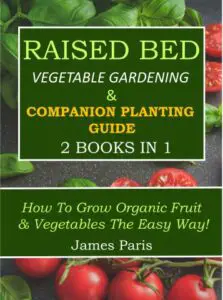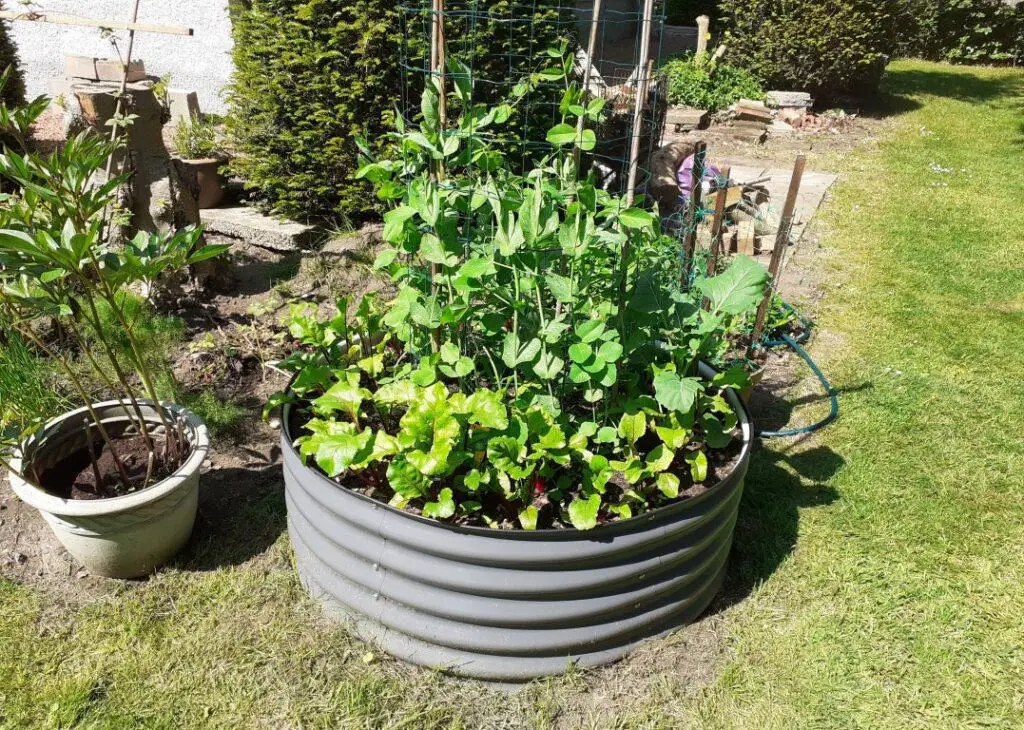Pro’s of Metal Garden Beds.
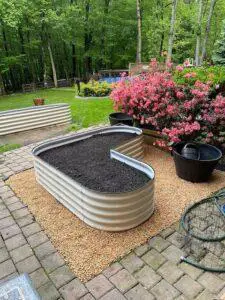
The galvanized or ‘aludized’ metal beds that you can purchase online, or make yourself. Can have many advantages over wooden beds such as…
- Galvanized steel is 3 times Longer lasting than wood. A Galvanized metal bed should easily last 25 years or more.
- Metal beds do not absorb the water in the same way that wooden beds do – even if they are lined.
- No risk of contamination. Galvanized metal beds means no risk of contamination. Mainly from preservative leaking into your soil. This may be especially important if you are growing vegetables to feed the family.
- Easy assembly. The better-quality Metal Garden Beds are quicker to assemble. Put in place ready to infill.
- Stylish and Modern Look. Galvanized metal beds come in a variety of shapes and sizes. And colors to choose from! This gives a very modern/industrial/chic look to any garden.
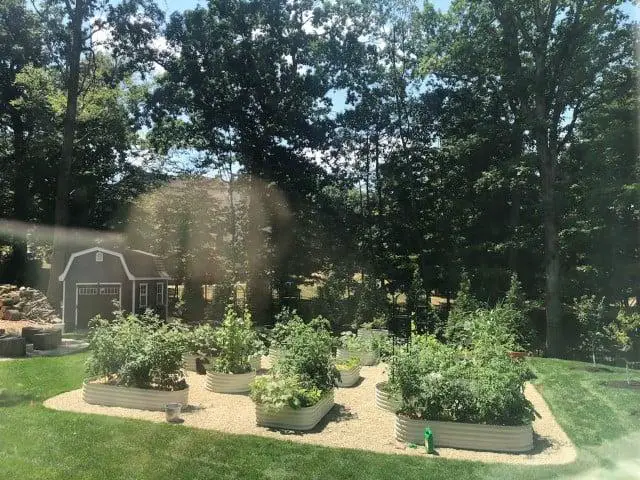
Disadvantages of Metal Raised Beds over Wood?
Like everything in life, there are at least 2 sides to most stories. That said, it would be unfair of me not to mention some of the disadvantages of using metal garden beds.  Compared to timber beds.
Compared to timber beds.
- Galvanized steel beds are more expensive than wooden: A timber garden bed of equivalent size would around 1/3rd of the price of a good metal bed.
- Steel beds tend to cool down quicker in the evening as unlike their wooden counterparts they do not store heat.
- Can be sharp around the edges – this is more prevalent in poor quality garden beds made from thinner steel.

What Material Makes The Best Raised Bed Garden
Growing plants in raised garden beds is one of the most productive ways to grow vegetables. Fruit trees and flower beds grow just as well.
Using raised garden beds has many advantages over traditional row gardening. This is whether you use metal raised beds or wooden structures.
Many gardeners think that Galvanized steel raised beds are better than wooden beds. But there are many advantages to using Raised Garden beds in general. Particularly if you are a vegetable gardener.
are better than wooden beds. But there are many advantages to using Raised Garden beds in general. Particularly if you are a vegetable gardener.
Some of the advantages of using raised garden beds Include…
- Ease of operation. The raised aspect of the bed means you have little in the way of bending over to tend your garden. No more aching back after a day caring for the vegetable plot!
- Much less weeding. If you have made up the bed with proper infill (see here
 ) then you will have very little weeding to do in the first season. Thereafter any weeding that needs done is a simple matter because of the friability of the soil.
) then you will have very little weeding to do in the first season. Thereafter any weeding that needs done is a simple matter because of the friability of the soil. - Longer growing season. The fact that the bed is raised off the cold ground means that it warms up sooner in the season, and cools down later.
- Versatility. The option remains to cover the structure (wood or metal). Done with either polythene to make a mini-polytunnel. Excellent for lengthening the growing season and the plants you can grow. Or with butterfly netting to prevent butterfly or bird damage to fruit crops.
- Raised Garden Beds are more Productive. There are many reasons why this is so, including those mentioned above. They are also more productive because you can grow plants much closer together. This is due to the fact that the growing medium (soil) is highly conducive to growing healthy crops.
Why I prefer Metal Raised Garden Beds
- Metal beds last longer overall. Galvanized or Aludized metal last 20 years plus. This against typical wood beds only reaching 5-10 years on average.
- Metal beds may seem expensive, but over time are actually cheaper owing to the short term nature of wood and the possible cost of treatment over the years.
- Self assembly metal garden beds such as the ‘Vegega’ brand are quick to assemble, and offer adaptable shapes to suit any garden or yard.
- Metal beds are impervious to damage by termites, rodents or wood rot.
- No need for regular treatment when using galvanized or aludized metal garden beds.
- Vegega beds are certified by the USDA as non toxic and safe to use.
- Rubber strips and smooth corrugated surfaces mean no fear of wood plinters when using.
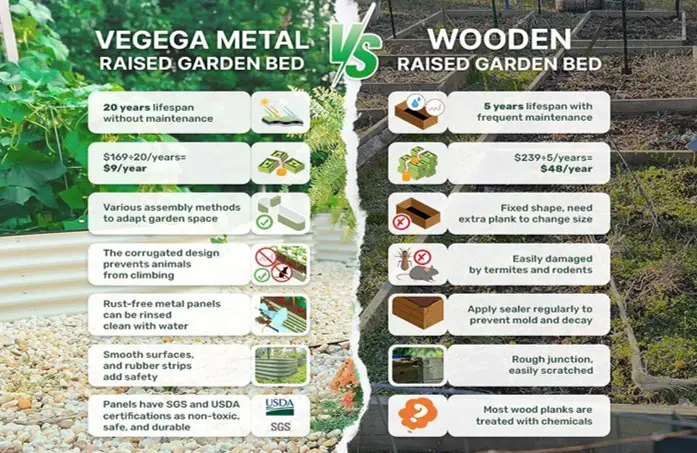

How Deep Should A Raised Garden Bed Be?
This is largely dependent on the needs of the plants you intend to grow. As a general guide, beds should be at least 6inches deep.
If the bed is already set on good soil then this can be as shallow as 4 inches (10cm) and upwards.
Consider for example if you are growing root vegetables such as carrots or parsnips. In this case the bed would need to be a minimum of 12 inches to 18 inches deep (300-450cm). For most varieties, otherwise the root will bend and be constricted.
BEST QUALITY ‘VEGEGA’ METAL RAISED BEDS – US
Metal Raised Garden Beds – UK
The Best Mix For A Raised Garden Bed
A Raised bed should never be filled with ‘normal’ topsoil. This will compact over time and will not produce the best results.
A good mix for a raised bed garden (More on this here.. ) allows a good friability that in turn allows for good root growth with no obstruction.
) allows a good friability that in turn allows for good root growth with no obstruction.
It should also be nutrient-rich and able to hold enough water and nutrients. This will encourage healthy growth in plants of all species.
As a general rule-of-thumb. 1/3rd compost. 1/3rd vermiculite or perlite. 1/3rd quality topsoil gives great results for most veggies and fruit plants.
Deep root vegetables like carrots for example would benefit by having a 25% washed sand. This assists drainage and free passage of the taproot.
How to Fill A Deep Garden Bed Cheaply
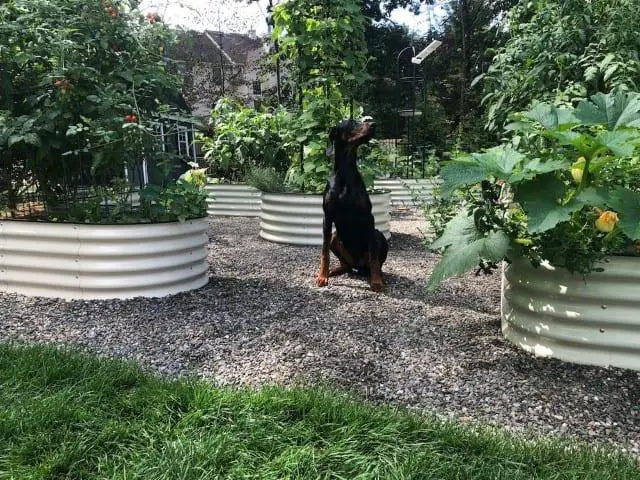
A deep Raised Garden Bed can be filled quite cheaply – if you know how!
One of the disadvantages of deep Raised Beds is that they can be quite expensive to fill. Add this to the cost of the Bed itself and the overall cost can be prohibitive.
The good news is that there are a few cheap solutions that I may be able to help you with.
- Partially fill with straw bales: This can be an excellent solution for deep beds at 24 inches deep or more. Simply get a few cheap straw bales from a local farmer (if you can) and tip them into the Bed. As long as you have at least 12 inches of soil mix on top, this will do most vegetables. Except deep roots as discussed above. Yes, the bales will gradually settle as they decompose. But they will make excellent drainage and friability to the mix over time.
- Fill the base with sticks and branches then top-off with your soil mix. This creates a similar effect to a Hugelkultur (More on this Hugelkultur method
 here…). This will settle over time, but will cut down the initial cost.
here…). This will settle over time, but will cut down the initial cost. - If you have a Bed over 18 inches deep but only need 6 inches or so for your plants. In this case fill with rubble and stones (make sure there is no old lime mortar attached.) Do this until an approximate level then top-off with your soil mix.
Decision time – Metal Garden Beds or wood?
I believe that the main consideration for many people – is the total cost. If budget is not so much an issue, then I would always choose the Galvanized steel Garden Beds.
But, if timber is plentiful and cheap where you are, then timber may be the best option for you. Both options can – and will – produce amazing results.
Some FAQ’S About Raised Garden Beds
- Q: What are the advantages of raised bed gardening?
- A: Raised beds provide improved drainage, are easier to weed and service plants. They also allow easier access for planting and harvesting crops.
- Q: Apart from metal and wood, what materials can I use to build raised beds?
- A: Other popular materials include, cinder blocks, bricks, or recycled composite materials.
- Q: How deep should a raised bed be for vegetables?
- A: A depth of 12 to 18 inches is generally enough for most vegetables. Though some shallow rooted herbs & veg can grow in as little as 4 inches (10cm)
- Q: What type of soil is best for raised beds?
- A: A well-draining mix of topsoil, compost, vermiculite and sand. This is ideal for most vegetables.
- Q: Can I place a raised bed on grass?
- A: Yes, but it is recommended to remove the grass or use a barrier. This prevents weeds and wrack from growing up through the soil. Cardboard or weed fabric will do the job.
- Q: How often should I water raised beds?
- A: Water when the top inch or more of soil feels dry; the frequency depends on the weather and the plants being grown. I Use the ‘knuckle test’ as a quick test. Dip your finger down to the second knuckle and if there is no soil sticking to it then it is probably too dry.
- Q: What vegetables are well-suited for raised beds?
- A: Many vegetables and herbs thrive in raised beds, including tomatoes. Peppers, lettuce, and potatoes, cabbage, and root vegetables of all kinds.
- Q: Do raised beds require fertilizer?
- A: Yes, but not as often as you may think if you are using rotation gardening methods. Adding organic fertilizers or compost annually helps replenish nutrients.
- Q: Can I use raised beds for small spaces like balconies or patios?
- A: Yes, smaller raised beds or container gardens work well in confined spaces. This is especially the case for Square Foot Gardening.
- Q: How do I protect raised beds from pests?
- A: Companion planting, natural predators, and organic pest control help cut pest issues. Raised beds are also easy to cover with garden fleece or butterfly netting. Between them will discourage most garden pests.
It is always worth noting that success with any gardening method does vary based on location. This and climate, and the individual needs of the plants you’re growing.
Final Word:
Whether you choose wood or metal Raised beds, both share the same disadvantage in the short term – they can be expensive to buy and to fill – especially in the case of deep beds. (See more tips on how to fill raised beds cheaply in this post ).
).
However in the long term I believe that the aludized metal beds come out tops. This is mainly on the longevity issue but also the reasons described at the top of this post.
Check out Vegega Best Quality Galvanised Steel beds – US
Metal Raised Garden Beds – UK
Happy Gardening!

